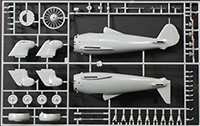
Hasegawa 1/32 P-26A Peashooter Kit First Look
By Michael Benolkin
| Date of Review | February 2017 | Manufacturer | Hasegawa |
|---|---|---|---|
| Subject | P-26A Peashooter | Scale | 1/32 |
| Kit Number | JS092 | Primary Media | Styrene |
| Pros | Easy build, nice details | Cons | See text |
| Skill Level | Basic | MSRP (USD) | OOP |
First Look
 |
 |
 |
Boeing's P-26 Peashooter had the distinction of being the company's first and last production monoplane fighter (not counting those aircraft being turned out by the Boeing-acquired McDonnell Douglas decades later). The aircraft was also distinctive as it was the US Army's first all-metal design airframe but still revealed its biplane heritage with the external wires used to strengthen the wings. The aircraft entered service in the mid-1930s with the US Army Air Corps, and retired prior to the US entry into World War Two. A number of aircraft were provided to the Philippines, who used the Peashooter in combat against the Japanese. China had been provided export versions of the P-26 which may have seen combat in that region as well.
While Hasegawa has been in existence since 1941, it didn't enter the plastic model market until the early 1960s and had found success with their box scale kits of the day. By the early 1970s, Hasegawa had settled into what we consider 'standard scales' for their kits and by that time had produced an impressive catalog of kits. Pushing into 1/32 scale, Hasegawa released kit number 92 in the early 1970s, the Boeing P-26A was one of a quartet of kits which featured between-the-wars US military aircraft consisting of the P-12E, BF2C, F4B-4, and P-26A Peashooter. Many of us have owned these kits or have them stashed away in our collections.
When these kits were first released, Hasegawa was being imported into the US market by another familiar name - Minicraft. When you first saw the labels, you might have thought they were the same company - Hasegawa-Minicraft. Eventually, they were de-hyphenated as Hasegawa moved to another importer and Minicraft would go on to bring Academy kits into the US market before they too were de-hyphenated.
The kit is molded in injection-molded styrene and presented on two parts trees plus a small clear part (the windscreen). The surface detailing is raised which is just perfect, because the surface detailing on the full-scale aircraft was raised as well.
Among the features and options in this kit:
- Basic cockpit
- Nice pilot's seat though pilot restraints should be added
- R-1340 Wasp radial engine
- Positionable flaps
- Elevators are not positionable but can be repositioned with careful surgery
- Optional centerline bomb rack with bombs
The decal instructions provide four subjects:
- P-26A, 34 AS/17 PG, 23
- P-26A, 17 PG, 101
- P-26A, Philippine AF, 2
- P-26A, 1 PS/17 PG, 93
Kits out of this series have been reissued a few times over the decades and it is nice to see it on the shelf even for a short time.
Unlike the P-12E and F4B-4 kits, this kit has the Wasp engine molded with the cylinder heads, crank case, crank case front with pushrods, and heat shield separately. In the P-12E and F4B kits, the Wasp engines are molded as one integral unit wit only the intake manifold and exhaust stubs molded separately. There are some aftermarket conversions for this, but if you're building the P-12E and/or F4B-4, it might be cheaper to acquire an inexpensive P-26 or two for the engine.
One of the more intimidating aspects of early aircraft is the rigging and in this kit, Hasegawa does provide rigging instructions. There are good photo walk arounds of the aircraft online including here.
While the MSRP on the new 'reissues' has migrated well north of $50 USD, I found this one for less than half of that and I'm sure you can do better at kit swaps and contest vendor rooms if you shop around.
While this kit may be over 40 years old, the details hold up well to contemporary standards and will a little work, will build into a beautiful model. While we sometimes get lost in the world of low-visibility camouflage or WW2 camouflage, we sometimes forget about the colorful aircraft flown by the US Army and US Navy between the wars. Step back into yesteryear...







